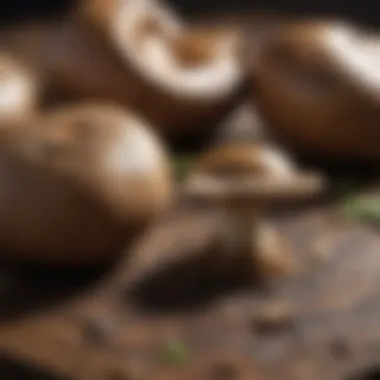Unlocking the Secrets of Portobello Mushroom Kits


Intro
Portobello mushrooms have garnered significant attention in the realm of home gardening and culinary circles. Known for their rich flavor and meaty texture, these fungi offer not only a delightful addition to various dishes, but they also present a unique opportunity for sustainable agriculture in urban settings. The Portobello mushroom kit facilitates easy cultivation at home, making it accessible to both novice gardeners and seasoned chefs. This article aims to provide a thorough examination of the portobello mushroom kit, detailing everything from its cultivation methods to its practical culinary applications.
Overview
The portobello mushroom, scientifically known as Agaricus bisporus, exists in several stages of growth, from white button to cremini and ultimately to portobello. Each of these stages contributes distinct flavors and textures, but the mature portobello stands out for its robustness, making it particularly popular in vegetarian cuisine.
Cultivating portobello mushrooms can be a gratifying experience. With the right kit, monitoring environmental conditions, and proper maintenance, anyone can enjoy harvesting their own mushrooms.
Cultivation Basics
Understanding the basic aspects of cultivation is fundamental to successfully growing portobello mushrooms. Factors like humidity, temperature, and lighting play pivotal roles. Here are some key points to consider:
- Temperature: Ideal growing temperatures typically range from 60°F to 75°F.
- Humidity: High humidity, around 85-90%, is crucial during the incubation phase.
- Lighting: Portobellos do not require direct sunlight, but light exposure is necessary for the initiation of fruiting.
Using a dedicated mushroom kit simplifies this process, as it usually contains the necessary substrate and a controlled environment for growth.
Uses in Culinary Applications
Culinary enthusiasts often cherish the portobello mushroom for its versatile nature. Here are some popular uses:
- Grilling: Portobello mushrooms can be marinated and grilled, enhancing their umami flavor.
- Stuffing: Their large caps provide a perfect vessel for various fillings, ranging from cheese to grains.
- Soups and Sauces: Chopped portobello can add depth to soups and sauces, enriching the overall taste.
Portobello mushrooms serve as a suitable substitute for meat in many recipes, appealing to vegetarians and those seeking to reduce meat consumption.
Nutritional Benefits
In addition to their culinary uses, portobello mushrooms are packed with various nutrients. They are low in calories and rich in vitamins such as B2, B3, and B5. Portobellos also provide important minerals, including selenium and potassium. Their content of antioxidants makes them a valuable addition to any diet, promoting overall health.
“The nutritional profile of portobello mushrooms supports heart health and may help to prevent certain chronic illnesses.”
Epilogue
Prelims to Portobello Mushrooms
Portobello mushrooms hold a notable place in both culinary applications and home cultivation. Their significant flavor and meaty texture make them a popular choice for various dishes. Understanding the nuances of these mushrooms can enhance the experience of both growing and preparing them. This section aims to unpack the foundational elements surrounding portobello mushrooms, highlighting their relevance in today’s context of sustainable living and healthy eating.
Understanding Portobello Mushrooms
Portobello mushrooms are a mature version of the Agaricus bisporus species, which also includes the button and cremini varieties. They are characterized by their large, flat caps that can reach up to six inches in diameter. The color can vary from light brown to dark brown, providing a range of options for consumers and growers alike. It is essential to recognize that they can absorb flavors efficiently, which enhances their appeal in diverse culinary practices.
Their popularity is driven by a combination of taste and nutritional value. Portobello mushrooms are a source of protein, fiber, and various vitamins and minerals. This makes them a viable meat substitute for vegetarians and vegans, helping to meet dietary needs with a plant-based option. Furthermore, as home gardening gains traction, portobello mushrooms stand out owing to their relatively easy cultivation process, which allows for an engaging experience for hobbyist growers.
Key Characteristics
Several key characteristics define portobello mushrooms, setting them apart from other types.


- Size and Shape: They are larger than most edible mushrooms, with a prominent flat cap and thick stems. This size makes them suitable for grilling or stuffing.
- Flavor Profile: Portobellos have an earthy, robust flavor that intensifies when cooked. Their umami taste can elevate simple dishes, enhancing the overall dining experience.
- Nutritional Content: These mushrooms are rich in B vitamins, potassium, and antioxidants, contributing positively to overall health. They are low in calories, making them an attractive option for health-conscious individuals.
- Culinary Versatility: Chefs often incorporate portobello mushrooms in a wide variety of recipes, spanning from salads to main courses. Their dense structure allows them to be grilled, roasted, or used as a meat substitute in burgers or stir-fries.
The rich profile of characteristics regarding portobello mushrooms not only emphasizes their culinary uses but also highlights their place in sustainable dietary practices. As more people seek ways to grow their own food, portobello mushrooms represent an accessible entry point into the world of mushroom cultivation.
What is a Portobello Mushroom Kit?
Understanding what a Portobello mushroom kit is essential for anyone interested in home cultivation. These kits provide a structured approach to growing mushrooms and are suitable for both novices and experienced growers. The significance of these kits lies in their convenience and comprehensiveness, as they contain all necessary components for successful cultivation. By using a kit, growers can avoid many of the initial hurdles associated with mushroom farming.
Components of the Kit
A typical Portobello mushroom kit comprises several key components that facilitate the cultivation process. Each element serves a specific purpose in ensuring a conducive environment for mushroom growth.
- Spawn: The mycelium or spores that will produce the mushrooms.
- Substrate: Usually a blend of organic materials that provide nutrients.
- Container: A designated space for mixing the substrate and spawn.
- Instructions: Detailed guidelines on maintaining optimum conditions and harvesting mushrooms.
These components work together to create an ideal environment for the fungi development. Understanding each part’s role can help growers maximize their yield.
Types of Portobello Kits Available
There are various Portobello mushroom kits available on the market, catering to different needs and preferences. Here are some common types:
- Beginner Kits: Designed for entry-level growers, these kits come with simple instructions and basic materials.
- Advanced Kits: These offer more complex cultivation methods and higher-quality spawn.
- Organic Kits: Utilizes organic substrates and fertilizers to appeal to eco-conscious consumers.
- All-in-One Kits: These include everything for a complete growing cycle, from substrate to harvest.
Choosing the right type of kit is crucial based on one’s experience level and goals in mushroom cultivation. Each option presents unique advantages, allowing home growers to select a kit that aligns with their culinary aspirations and environmental preferences.
Benefits of Using a Portobello Mushroom Kit
The utilization of a Portobello mushroom kit brings several advantages to aspiring home growers. These kits are designed to simplify the cultivation process, making it accessible to individuals without extensive knowledge or experience in mushroom farming. This section delves into the specific elements that highlight the benefits of such kits, particularly emphasizing convenience and educational value.
Convenience for Home Growers
For many, growing mushrooms at home might seem like a complex venture. Portobello mushroom kits are structured to reduce this complexity. They combine essential elements needed for growth, such as substrates and spores, into a single package. This integration allows anyone, even those with no prior experience, to embark on a successful cultivation journey.
Using a Portobello mushroom kit means there is no need to source individual components. Customers can often start the process immediately upon receiving the kit, saving time and effort. Additionally, these kits often come with detailed instructions outlining the necessary steps from preparation to harvest.
In terms of space, many kits are compact and can be managed in smaller living environments, like apartments or small homes. This adaptability appeals to urban gardeners who might lack access to large outdoor spaces. Furthermore, maintaining optimal humidity and temperature levels is often less of a worry, as many kits provide supportive materials designed to create the right microclimate.
Educational Value
Engaging with a Portobello mushroom kit offers significant educational benefits. As individuals cultivate mushrooms, they learn about the biological processes behind growth and development, including mycelium formation, fruiting, and the environmental factors that influence these stages.
Such hands-on experiences contribute to a deeper understanding of biology. This is particularly beneficial for families looking to introduce their children to agricultural and ecological concepts in a practical manner. Observing and participating in the growth cycle can ignite curiosity about food origins and sustainable practices.
Moreover, many kits include information about the nutritional benefits of Portobello mushrooms. This fosters awareness about healthy eating habits and the importance of incorporating diverse food sources into diets. By bridging cultivation and cooking, individuals become even more involved in understanding the entire food journey.
Engaging in mushroom cultivation invites exploration on biology, nutrition, and sustainability.
The Cultivation Process


The cultivation process of portobello mushrooms is crucial for achieving a successful yield. Understanding the steps involved can lead to an efficient and productive growing experience. By preparing adequately, you can minimize challenges and maximize the benefits of home cultivation. Each stage is vital, as it determines the quality and quantity of the mushrooms produced. Through careful attention to detail, growers can create an optimal environment conducive to healthy mushroom development.
Preparing the Growing Environment
The first step in cultivating portobello mushrooms is to prepare the growing environment. This involves selecting an appropriate location, managing temperature, and ensuring proper humidity.
- Location: A shaded area or a dark space is ideal. Portobello mushrooms thrive in low-light conditions. This can be achieved indoors or in a greenhouse.
- Temperature: Portobello mushrooms prefer a temperature range of 55°F to 75°F (13°C to 24°C). It's important to maintain a stable temperature to avoid stress on the mushrooms.
- Humidity: Keeping humidity levels between 85% and 90% is essential. This can be done by misting the growing area regularly or placing a humidifier nearby.
Once these factors are optimized, you can proceed to select the growing medium, usually comprised of compost or straw, which provides essential nutrients.
Inoculation and Incubation
Inoculation is the process of introducing mushroom spores to the prepared growing medium. This step is key to initiating the growth cycle.
- Selecting Spores: Choose high-quality spores specifically for portobello mushrooms. They can often be found in kits or can be sourced from reputable suppliers.
- Inoculation Process: Ensure all tools used are sterilized to prevent contamination. Spread the spores evenly across the medium, mixing them gently.
- Incubation: Following inoculation, the mixture should be kept in a dark environment at the recommended temperature for about two to four weeks. During this time, mycelium will begin to grow and colonize the medium. Monitoring humidity and temperature is crucial during this phase.
Successful incubation leads to more robust growth and higher yields.
Harvesting Techniques
Once the mushrooms mature, the final stage is harvesting. Proper techniques ensure that the quality of the mushrooms is preserved.
- Timing: Harvest portobello mushrooms just before the cap expands fully. This is when they are the most flavorful.
- Technique: Use a sharp knife to cut the stem at the base. Avoid pulling them out as this can damage the mycelium. Careful handling reduces the chance of bruising.
- Post-Harvest Care: Clean the harvested mushrooms with a damp cloth to remove any debris. Ideally, they should be consumed fresh but can also be stored in the refrigerator for short periods.
Sustainability Aspects of Mushroom Cultivation
Mushroom cultivation is increasingly recognized for its sustainability, specifically regarding how it interacts with environmental concerns and resource management. Portobello mushrooms, in particular, play a significant role in this discourse. Their cultivation practices not only minimize environmental footprints but also offer unique solutions to various waste management issues. Understanding these sustainability aspects is essential for anyone looking to grow mushrooms, whether for personal use or commercial purposes.
Environmental Impact
The environmental impact of mushroom cultivation is largely positive. Unlike many traditional crop farming practices, mushroom growing requires less land and produces less pollution. Portobello mushrooms flourish on substrates that are often by-products of other agricultural processes, such as straw and wood chips. This method of cultivation helps in preserving natural ecosystems by utilizing materials that would otherwise be discarded.
Additionally, mushrooms sequester carbon dioxide while growing, thus contributing positively to carbon cycles. This makes them an important element in efforts to combat climate change. With a relatively small carbon footprint, the cultivation of Portobello mushrooms has shown the potential to foster more sustainable food systems.
One of the critical points in the environmental discussion is water usage. Mushroom farming demands significantly less water compared to conventional agriculture. In regions facing water scarcity, this factor makes mushroom cultivation, especially using kits, an appealing alternative.
"Mushroom cultivation presents a unique opportunity to address food security while reducing environmental impact." - Anonymous
Waste Utilization
Mushroom cultivation encompasses more than just crops; it embraces waste as a resource. Portobello mushroom kits, for instance, utilize organic materials such as sawdust, wheat straw, and coffee grounds to create substrates for mushroom growth. These materials not only serve as nourishment for the mushrooms but also assist in diverting waste from landfills. This is crucial in a world where waste management is an ever-increasing challenge.
Moreover, after mushroom harvest, any leftover substrate can be repurposed as a nutrient-rich compost. This compost can be returned to gardens or agricultural lands, enriching the soil and fostering plant growth. The cyclical nature of mushroom cultivation promotes a sustainable model that aligns with circular economy principles. This means that every step in the cultivation process adds value rather than detracting from it.
In summary, the sustainability aspects of mushroom cultivation, particularly through the lens of Portobello mushrooms, illustrate a pathway toward environmentally friendly agricultural practices. Both the reduction in environmental impact and the thoughtful use of waste highlight the benefits of this often-overlooked form of farming.
Culinary Uses of Portobello Mushrooms


Portobello mushrooms hold a unique place in the culinary world. Their robust flavor and meaty texture make them a versatile ingredient for diverse dishes. This section emphasizes the importance of Portobello mushrooms within the broader context of cooking and nutrition. Understanding their culinary uses can enhance meal preparation and improve nutrition for those who appreciate savory, hearty meals.
Popular Recipes
There are various ways to enjoy Portobello mushrooms in different recipes. Below are some popular options that showcase their culinary flexibility:
- Grilled Portobello Burgers: A common alternative to beef, these burgers can be marinated and grilled, providing a filling option.
- Stuffed Portobello Mushrooms: Fill the caps with a mixture of cheeses, vegetables, and herbs for flavorful bites. This recipe serves as an ideal appetizer.
- Portobello Mushroom Risotto: They can be diced and added to creamy risotto, enhancing texture and taste.
- Sautéed Portobello Mushrooms: Quick to prepare, sautéed mushrooms can serve as a side dish or a topping for various entrees.
- Portobello Mushroom Pasta: Incorporating these mushrooms into pasta dishes brings a rich flavor, pairing nicely with sauces like Alfredo or marinara.
Nutritional Benefits
Portobello mushrooms are not just tasty but also nutritionally beneficial. Here are some key points regarding their nutritional value:
- Low in Calories: They are low in calories, making them suitable for weight management.
- High in Antioxidants: Portobello mushrooms contain selenium, an antioxidant that helps protect cells from damage.
- Source of Vitamins: They provide B vitamins, such as riboflavin and niacin, which are essential for energy metabolism.
- Rich in Minerals: Minerals like potassium are present, contributing to heart health and regulating blood pressure.
- Dietary Fiber: They have a decent fiber content, aiding in digestion.
Portobello mushrooms serve as a great vegetarian substitute while providing multiple health benefits through their rich nutritional profile.
Incorporating Portobello mushrooms into one's diet can lead to delicious and healthful meals, making them a significant choice for various culinary applications.
Challenges in Cultivating Portobello Mushrooms
Cultivating portobello mushrooms can present various challenges. Understanding these obstacles is crucial for both novice and experienced growers. Attention to detail in each phase of cultivation helps maximize yield and ensure quality.
Common Pests and Diseases
Pests and diseases are significant issues that can impact the success of portobello mushroom cultivation. Some common pests include:
- Mushroom fly: Often seen hovering around the substrate, they lay eggs that hatch into larvae feeding on the mushrooms.
- Spider mites: These tiny pests can weaken the plant, leading to lower yields.
- Fungi: While beneficial fungi assist mushroom growth, certain mold species can overpower the growing mycelium.
To prevent and control these problems, consider maintaining appropriate humidity and avoiding overwatering. Regular monitoring of the growing environment is also essential. If pests are spotted, using organic pest control methods can be effective without harming the mushrooms.
Troubleshooting Growth Issues
Growth issues can arise, even with the best practices in place. Some common problems include:
- Slow growth rates: Several factors can contribute, including temperature fluctuations or insufficient humidity.
- Poor fruiting: If mushrooms do not form properly, it may be due to inadequate light or improper substrate preparation.
- Discoloration: Color change in mushrooms or substrate may signal contamination or insufficient nutrients.
Identifying the root cause of these issues is essential. For slow growth, assess the environmental conditions. Adjusting the temperature or humidity can lead to improved performance. For poor fruiting, ensuring adequate airflow and light exposure will aid in development.
In sum, addressing cultivation challenges effectively will enhance the experience of growing portobello mushrooms at home. Proper education on pests, diseases, and troubleshooting techniques equips growers with the knowledge needed for sustained success.
Epilogue
The exploration of the Portobello mushroom kit illuminates various vital facets crucial for both novice and experienced growers. This section reflects on the significance of cultivating Portobello mushrooms not merely as a hobby, but as an integral part of sustainable practices and culinary innovation.
The Future of Mushroom Cultivation
Mushroom cultivation is evolving. With increasing awareness about food sustainability, more individuals are turning to self-cultivation methods. Advances in technology influence the growing techniques, leading to higher yields and better quality mushrooms. Companies are developing innovative kits that cater to specific conditions and expand the types of mushrooms available for home growers. Moreover, ongoing research into the nutritional benefits of mushrooms, including Portobellos, spurs greater interest in their cultivation. This trend signals a bright future where mushrooms play a central role in food security and health.
Encouragement for New Growers
Venturing into mushroom cultivation, particularly Portobello mushrooms, can be daunting yet rewarding. There are resources available to make the process easier. Engaging in local or online communities offers support and shared experiences. Growers should be patient and observant, as mistakes are part of the learning journey. Starting small with a beginner's kit can build confidence before tackling larger projects. Remember, each success contributes to personal growth and a deeper understanding of sustainable agriculture.
“Small successes lead to bigger ambitions in the world of cultivation.”
In summary, the Portobello mushroom kit is more than a simple growing kit; it represents an opportunity for personal enjoyment, enhanced nutrition, and engagement with eco-conscious practices. The future of mushroom cultivation is bright, and new growers play a critical role in this evolution.







